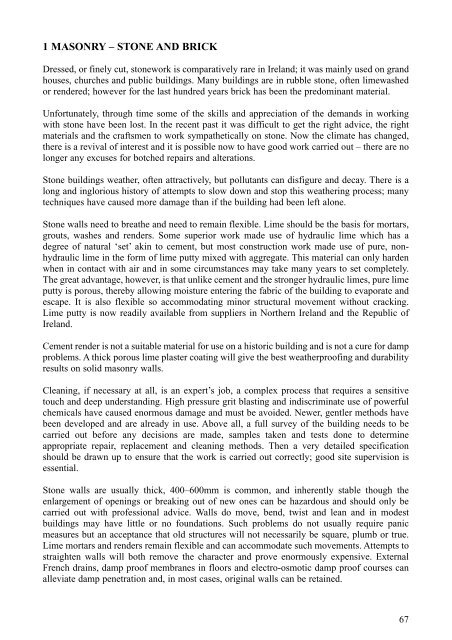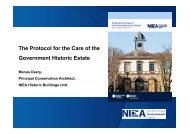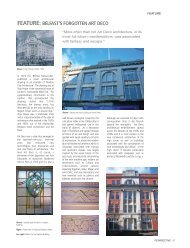Directory of Traditional Building Skills - Mourne Heritage Trust
Directory of Traditional Building Skills - Mourne Heritage Trust
Directory of Traditional Building Skills - Mourne Heritage Trust
Create successful ePaper yourself
Turn your PDF publications into a flip-book with our unique Google optimized e-Paper software.
1 MASONRY – STONE AND BRICKDressed, or finely cut, stonework is comparatively rare in Ireland; it was mainly used on grandhouses, churches and public buildings. Many buildings are in rubble stone, <strong>of</strong>ten limewashedor rendered; however for the last hundred years brick has been the predominant material.Unfortunately, through time some <strong>of</strong> the skills and appreciation <strong>of</strong> the demands in workingwith stone have been lost. In the recent past it was difficult to get the right advice, the rightmaterials and the craftsmen to work sympathetically on stone. Now the climate has changed,there is a revival <strong>of</strong> interest and it is possible now to have good work carried out – there are nolonger any excuses for botched repairs and alterations.Stone buildings weather, <strong>of</strong>ten attractively, but pollutants can disfigure and decay. There is along and inglorious history <strong>of</strong> attempts to slow down and stop this weathering process; manytechniques have caused more damage than if the building had been left alone.Stone walls need to breathe and need to remain flexible. Lime should be the basis for mortars,grouts, washes and renders. Some superior work made use <strong>of</strong> hydraulic lime which has adegree <strong>of</strong> natural ‘set’ akin to cement, but most construction work made use <strong>of</strong> pure, nonhydrauliclime in the form <strong>of</strong> lime putty mixed with aggregate. This material can only hardenwhen in contact with air and in some circumstances may take many years to set completely.The great advantage, however, is that unlike cement and the stronger hydraulic limes, pure limeputty is porous, thereby allowing moisture entering the fabric <strong>of</strong> the building to evaporate andescape. It is also flexible so accommodating minor structural movement without cracking.Lime putty is now readily available from suppliers in Northern Ireland and the Republic <strong>of</strong>Ireland.Cement render is not a suitable material for use on a historic building and is not a cure for dampproblems. A thick porous lime plaster coating will give the best weatherpro<strong>of</strong>ing and durabilityresults on solid masonry walls.Cleaning, if necessary at all, is an expert’s job, a complex process that requires a sensitivetouch and deep understanding. High pressure grit blasting and indiscriminate use <strong>of</strong> powerfulchemicals have caused enormous damage and must be avoided. Newer, gentler methods havebeen developed and are already in use. Above all, a full survey <strong>of</strong> the building needs to becarried out before any decisions are made, samples taken and tests done to determineappropriate repair, replacement and cleaning methods. Then a very detailed specificationshould be drawn up to ensure that the work is carried out correctly; good site supervision isessential.Stone walls are usually thick, 400–600mm is common, and inherently stable though theenlargement <strong>of</strong> openings or breaking out <strong>of</strong> new ones can be hazardous and should only becarried out with pr<strong>of</strong>essional advice. Walls do move, bend, twist and lean and in modestbuildings may have little or no foundations. Such problems do not usually require panicmeasures but an acceptance that old structures will not necessarily be square, plumb or true.Lime mortars and renders remain flexible and can accommodate such movements. Attempts tostraighten walls will both remove the character and prove enormously expensive. ExternalFrench drains, damp pro<strong>of</strong> membranes in floors and electro-osmotic damp pro<strong>of</strong> courses canalleviate damp penetration and, in most cases, original walls can be retained.67











